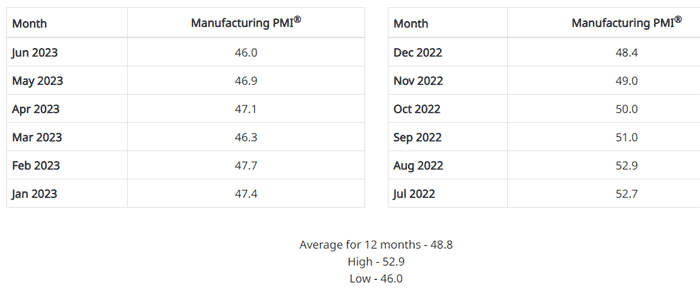The US Purchasing Managers Index (PMI) for June from the Institute for Supply Management (ISM) came at a level of 46, down 0.9 percentage point versus the 46.9 recorded in May, and also below the key 50 mark that separates US manufacturing expansion from contraction for the eighth straight month.
Before that the US saw a 28-month period of manufacturing growth after May 2020, not long after the start of the pandemic earlier that year.
The PMI tracks closely but not exactly with the overall US economy. The June PMI indicates a seventh month of overall economic contraction after a 30-month period of expansion.
What’s more, the New Orders Index remained in deep contraction territory at 45.6, though that was up from 42.6 seen in May, in bad news for future US manufacturing activity.
It was mostly bad news in other related measures as well. For example the Production Index had a reading of 46.7, a 4.4-percentage point decrease compared to May’s figure of 51.1 and indicating contraaction.
The Prices Index registered 41.8, down 2.4 percentage points compared to the May figure of 44.2. That means companies saw a significant decrease in the cost of components, materials and other inputs. This index (below 50 = falling prices), was just a few months ago above 80, as inflation took off.
In more bad economic news, the Backlog of Orders Index registered a very low 38.7, 1.2 percentage points higher than the May reading of 37.5 , meaning order books are shrinking dramatically with the level well belowt the 50 mark.
The Supplier Deliveries Index figure of 45.7 is 2.2 percentage points higher than the 43.5 recorded in May. This figure, along with the previous seven, is the Supplier Deliveries Index’s lowest reading since March 2009 (43.2). Supplier Deliveries is the only ISM index that is inversed; a reading of above 50 percent indicates slower deliveries, which is typical as the economy improves and customer demand increases.
The Inventories Index dropped 1.8 percentage points to 44.0; the May reading was 45.8, also below the key 50 mark, indicating inventory levels at companies are decreasing.
"The U.S. manufacturing sector shrank again, with the Manufacturing PMI losing ground compared to the previous month, indicating a faster rate of contraction. The June composite index reading reflects companies continuing to manage outputs down as softness continues and optimism about the second half of 2023 weaken," commented Timothy Fiore, Chair of the Institute for Supply Management Manufacturing Business Survey Committee.
(See More Below)
|
CATEGORY SPONSOR: SOFTEON |
|
|
| |
| |
|
|
As always, the ISM report provides a graphic of the full PMI scores for the last 12 months, which as can be seen has the measure trending down since June of 2022, and it is now averaging just 48.8 over the past year, below the key 50 level.
US PMI Last 12 Months

Source: ISM
Just four of the 18 industry US sectors tracked by the PMI reported growth in June: Printing & Related Support Activities; Nonmetallic Mineral Products; Primary Metals; and Transportation Equipment.
As always, there were some interesting comments from PMI survey respondents.
“Maintaining a strong order backlog. Continue to struggle with hiring hourly factory workers and finding qualified management candidates — higher turnover than desired. Pricing has stabilized, but labor costs remain high
Added another respondent in the food/beverage sector: "There is an elevated level of capital project review as recession concerns loom. While not delayed, spending and planning are being managed and prioritized."
Finally, a manager in the metals sector said that "Maintaining a strong order backlog. Continue to struggle with hiring hourly factory workers and finding qualified management candidates - higher turnover than desired. Pricing has stabilized, but labor costs remain high."
Any reaction to this latest PMI data for June? Let us know your thoughts at the Feedback section below.
|